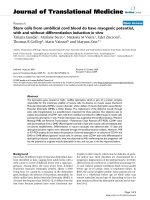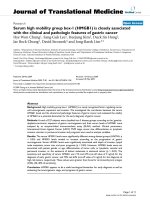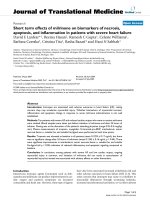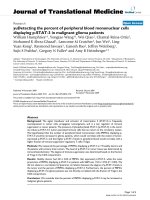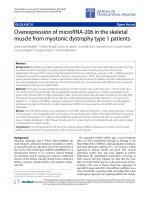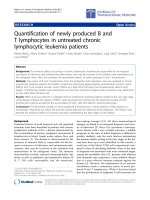báo cáo hóa học:" Rare ligamentum flavum cyst causing incapacitating lumbar spinal stenosis: Experience with 3 Chinese patients" pdf
Bạn đang xem bản rút gọn của tài liệu. Xem và tải ngay bản đầy đủ của tài liệu tại đây (833.87 KB, 4 trang )
CAS E REP O R T Open Access
Rare ligamentum flavum cyst causing
incapacitating lumbar spinal stenosis:
Experience with 3 Chinese patients
Alexander Pak-Hin Chan
*
, Tsz Cheung Wong, Koon-Man Sieh, Simon Siu-Man Leung, Kai-Yin Cheung,
Kwai-Yau Fung
Abstract
Three Chinese patients suffered from severe lumbar spinal stenosis with debilitating symptoms due to a rare condi-
tion of ligamentum flavum cysts in the midline of the lumbar spine. This disease is distinct from synovial cyst of
the facet joints or ganglion cysts, both intraoperatively and histopathologically. Magnetic Resonance imaging
features of the ligamentum flavum cyst are also demonstrated. We share our surgical experiences of identification
of the ligamentum flavum cysts, decompression and excision for two of the patients with demonstrably good
recovery. This disease should be considered in the differential diagnosis of an extradural instraspinal mass in
patients with lumbar spinal stenosis.
Background
Lumbar spinal stenosis is commonly caused by degenera-
tive conditions, such as herniated nucleus propulsus, or
hypertrophy of facet joint or ligamentum hypertrophy.
Less common aetiologies include intraspinal extradural
masses, including synovial cysts [1], ganglion cysts [2],
pseudocysts, haematoma, metastatic tumour. Cyst origi-
nated from ligamentum flavum is even more uncommon.
Few reported cases of spinal stenosis and radiculopathy
were caused by ligamentum flavum cysts and none of
these are from the Chinese population [3-8]. We describe
our experiences of Chinese patients sufferin g from spinal
stenosis due to ligamentum flavum cysts.
Case Presentation
Case 1
A 74-year-old man presented with 1-year history of pro-
gressive bilateral leg weakness with left side being more
affected. He walked with frame in the most recent
3 months. There was no history of trauma or other consti-
tutional symptoms.
Clinical examination revealed moderate weakness
(grade 3/5) of the left ankle dorsiflexion, flexion and
extension of the left great toe. Otherwise, motor exami-
nation of the other muscle groups was normal. Sensa-
tion of both lower limbs wa s intact. The left knee reflex
was diminished w hereas both side ankle reflexes were
absent.
Plain radiographs of the lumbosacral spine showed
degenerative changes. Blood parameters showed normal
white cell count (WCC), erythrocyte sedimentation rate
(ESR) and C-reactive protein (CRP). Magnetic Reso-
nance Imaging (MRI) scan showed a c ystic lesion, T1
hypointense and T2 hyperintense with moderate rim
enhancement in between dural sac and ligamentum fla-
vum at L3/4 level, compressing and displacing cauda
equina (Figure 1A, B).
The patient was treated conservatively with a short
course of analgesics and physiotherapy. This regimen
failed to alleviate the patient’s symptoms. Posterior
decompression by L3 laminectomy was performed. Intrao-
peratively, a cyst was noted in the epidural space spanning
the whole of ligamentum flavum in a transv erse and cra-
nio-caudal direction at L3/4 level. Two separate ganglion
cysts were also found on the dorsal side of both L3/4 facet
joints. The dorsal side of the ligamentum flavum cyst
extended in a space in the L3/4 interspinous space,
whereas the ventral wall was densely adhered to the dura.
The cauda equina was decompressed by excising the
* Correspondence:
Department of Orthopaedics and Traumatology, Alice Ho Miu Ling
Nethersole Hospital, Tai Po, New Territories, Hong Kong SAR, China
Chan et al. Journal of Orthopaedic Surgery and Research 2010, 5:81
/>© 2010 Chan et al; licensee BioMed Central Ltd. This is an Open Access article distributed under the terms of the Creative Commons
Attribution Licens e ( which permits unrestricted use, distribution, and reproduction in
any m edium, provided the original work is properly cited.
dorsal cyst wall and drainage of clear fluid inside. The ven-
tral wall could not be separated from the dura and was left
in-situ. Furthe r decompression of bilateral lateral canals
was performed by undercutting of the facet joints. Both
descending L4 nerve roots w ere decompressed from the
shoulders to the entry zone of neuroforamina. Histological
examination of the resected specimen demonstrate d
fibrous connective tissue devoid of lining epithelium.
Postoperatively, the patient showed relief f rom the
spinal claudication symptoms and improvements in
ankle dorsiflexion, left great toe flexion and extension
power to grade 4/5. He could walk with stick.
Case 2
The second patient was a 56-year-old male optician,
who sought orthopaedic consultation because of rapidly
progressing bilateral lower limb numbness and weakness
for 2 months. Walking tolerance was limited to less
than 5 minutes drastically in this period. Left side symp-
toms were more severe than right side.
Physical examination showed tenderness at lower lum-
bar spine, weakness of grade 4/5 over left extensor hallucis
longus muscle, with decrease in light touch sensation over
left L5 dermatome. Straight leg raising test was noted posi-
tive at 75 degrees on the left side with tension sign. Lower
limb reflexes were intact. All the features were compatible
with left sciatica with left L5 radiculopathy.
Radiograph of the lumbosacral spine demonstrated
grade I spondylolisthesis at L4/5 level with decreased
L4/5 intervertebral disc height. MRI of the same region
showed L4/5 disc bulging with severe s pinal stenosis
(Figure 1C, D).
Posterior decompression by L4/5 laminectomy was
performed. A midline cyst arising from the ligamentum
flavum with dense epidural adhesion at the midline was
noted (Figure 2). The cyst was freed from the dura and
excised with some adherent remnants at the midline.
Both descending L5 nerve roots were severely com-
pressed in the lateral canals. L4 and L5 pedicle screw
fixation, together with Transforaminal Lumbar Inter-
body Fusion (TLIF) of the L4/5 levels, were also done to
correct the spondylolisthesis. On histological examina-
tion, there was dense fibrous tissue identified from the
cyst wall.
After the operation, the patient could walk with stick
without any claudication symptoms. The left L5 radicu-
lopathy was completely resolved.
Case 3
The third patient was an 85-year-old lady with known
low back pain on and off for years. She also had history
of hypertension, hype rlipidaemia, old cere brovascular
accident. She presented with sudden deterioration in
back pain with bilateral lower limb num bness for
Figure 1 Patient 1: (A) Sagittal and (B) transverse T2-weighted MRI with contrast of t he lumbosacral spine shows a rim enhancing
cystic lesion (white arrow) centrally located at the L3/4 level compressing onto the cauda equina (grey arrow). Patient 2: (C) Transverse
and (D) sagittal T2-weighted MRI image shows Grade I spondylolisthesis and spinal stenosis at the L4/5 level being compressed by a huge cystic
structure (white arrow) with a thick cystic wall onto the cauda equina (grey arrow).
Chan et al. Journal of Orthopaedic Surgery and Research 2010, 5:81
/>Page 2 of 4
1-month. Physical examination s howed local tenderness
at the lower lumbar region. Lower limb neurology was
intact. X-ray of the lumbosacral spine showed degenera-
tive scoliosis. MRI of the lumbosacral spine showed pos-
tero-central disc protrusion at L3/4, L4/5 and L5/S1,
with lumbar spinal stenosis, L4/5 and L5/S1 facet joint
hypertrophy. There was a hyperintense cystic lesion at
L3/4 region on T2-weighted image over posterolateral
aspect of the d ura on th e left si de, compatible with a
ligamentum flavum cyst. However, the patient refused
decompression operation due to medical comorbidities.
She was provided with conservative management with
static progress.
Discussion
In the past, the occurrence of cysts arising from the pos-
terior elements of the spinal canal is termed juxta-facet
cysts [9]. However, with more cases and experiences
accumulated, there are specific features that we can dif-
ferentiate the various origins of the cysts. Identifying
and differen tiating the origin of the cystic lesions have
important implications to our surgical planning and the
extent of surgical exploration to achieve complete cyst
resection from its insertion and minimize the chance of
recurrence. Synovi al or ga nglion cysts of the facet joints
have been reported to cause nerve root compression in
the lumbar spine [1,2]. Synovial cysts communicate with
the facet joint, have a synovial lining (pseudostratified
columnar epithelium), and contain clear or xanthoch ro-
mic fluid [1]. The spinal ganglion cysts do not c ommu-
nicate with the facet joint cavity, have a fibrous tissue
wall, and are filled with a viscous, gelatinous material
[9]. However, ligamentum flavum cyst s represent a
unique entity being embedded in the inner surface of
ligamentum flavum with no epithelial lining and no
association with spinal facets [6-8].
The pathogenesis of ligamentum flavum cysts remains
unknown [6-8]. This condition likely reflects degenera-
tion rather than trauma. From the literature available,
hypertrophy of the ligamentum flavum, along with liga-
mentous degeneration and fi brosis, are frequently pre-
sent and likely to be sequelae of localized spinal trauma
[10]. The ligamentum flavum cyst is regarded to be
associated with microtrauma due to increased motion at
a particular motion segment or segmental instability and
local stress associat ed with degeneration at the level of
occurrence [11,12]. Cyst formation may be part of a
spectrum of more advanced ligamentous degeneration,
which includes, fibrosis and calcification [5]. Patients
with ligamentum flavum cysts are also noted to h ave
co-existence of facet joint degene ration, and inci dence
of degenerative spondylolisthesis varies between 42 and
65% [13]. This phenomenon was also noted in ou r first
and second patient respectively.
Most of the reported ligamentum flavum cysts in the
literature were located laterally within the spinal canal,
unlike the central l ocation of the cysts in o ur first two
patients. Improvements in pain and neurological func-
tion in the majority of patients suffering from laterally
located ligamentum flavum cysts after surgical decom-
pression have been documented [6,8].
Dense adhesions to the du ra entail surgical difficulties
for complete excision of the ligamentum flavum cysts,
which can minimize recurrence. Dural tear might com-
plicate the decompression surgery and cerebrospinal
fluid fistula can be one of the most unfavourable surgi-
cal sequela.
The natural history of this rare entity is unknown. The
progression of the symptoms can vary from acute to
subacute, as illustrated in the difference in symptom
duration and severity of our three patients. Whether a
cyst resorbs over time is unknown. The role of initial
non-operative treatment in the setting of clinical symp-
toms is warranted. Operation is reserved for those with
persistent neu rological symptoms and/or severe leg pain
refractory to non-operative treatment. Decompression of
the cysts contents and preferably, subsequent resection
of the cyst l ining can bring immediate relief of the
patient’s radicular symptoms.
Conclusions
The origin of ligamentum flavum cyst i s unknown. The
occurrence is extremely rare, but it should remain in the
differential diagnosis of any extradural intraspinal mass
and neurogenic claudication or lumbar radiculopathy.
This condition is surgically treatable.
Figure 2 Intraoperative photo shows the thickened
ligamentum flavum cyst wall (black arrow) in between spinous
processes (white arrows) upon posterior decompression by
laminectomy at L4/5 level.
Chan et al. Journal of Orthopaedic Surgery and Research 2010, 5:81
/>Page 3 of 4
Consent
Written informed consent was obtained from the
patients of this case report and accompanying images. A
copy of the written consent is available for review by
the Editor-in-Chief of this journal.
Acknowledgements
No acknowledgem ent.
Authors’ contributions
PHC, KMS and TCW were involved in the operative work-up, rehabilitation
and preparation of the manuscript. KYC was the chief surgeon of the
operations, while KMS, SML, PHC and TCW assisted the operations. KYF
initiated and coordinated the operative planning. All authors contributed
and approved the final manuscript.
Authors’ information
Alexander Pak-Hin Chan holds the position of Resident, Department of
Orthopaedics and Traumatology, Alice Ho Miu Ling Nethersole Hospital,
Hong Kong SAR, China
Tsz-Cheung Wong holds the position of Resident, Department of
Orthopaedics and Traumatology, Alice Ho Miu Ling Nethersole Hospital,
Hong Kong SAR, China
Koon-Man Sieh holds the position of Specialist, Department of Orthopaedics
and Traumatology, Alice Ho Miu Ling Nethersole Hospital, Hong Kong SAR,
China
Simon Siu-Man Leung holds the position of Associate Consultant,
Department of Orthopaedics and Traumatology, Alice Ho Miu Ling
Nethersole Hospital, Hong Kong SAR, China
Kai-Yin Cheung holds the position of Consultant, Department of
Orthopaedics and Traumatology, Alice Ho Miu Ling Nethersole Hospital,
Hong Kong SAR, China
Kwai-Yau Fung holds the position of Chief-of-service, Department of
Orthopaedics and Traumatology, Alice Ho Miu Ling Nethersole Hospital,
Hong Kong SAR, China
Competing interests
The authors declare that they have no competing interests.
Received: 23 August 2010 Accepted: 4 November 2010
Published: 4 November 2010
References
1. Onofrio BM, Mih AD: Synovial cysts of the spine. Neurosurgery 1988,
22(4):642-7.
2. Ogawa Y, Kumano K, Hirabayashi S, Aota Y: A ganglion cyst in the lumbar
spinal canal: a case report. Spine 1992, 17(11):1429-31.
3. Moile RH, Ehni G, Anderson MS: Nodule of the ligamentum flavum as a
cause of nerve root compression. J Neurosurg 1967, 27(5):456-8.
4. Haase J: Extradural cyst of ligamentum flavum L4-a case. Acta Orthop
Scand 1972, 43(1):32-8.
5. Abdullah AF, Chambers RW, Daut DP: Lumbar nerve root compression by
synovial cysts of the ligamentum flavum: report of four cases. J
Neurosurg 1984, 60(3):617-620.
6. DiMaio S, Marmor E, Albrecht S, Mohr G: Ligamentum flavum cysts
causing incapacitating lumbar spinal stenosis. Can J Neurol Sci 2005,
32(2):237-242.
7. Ayberk G, Ozveren F, Gok B, Yazgan A, Tosun H, Seckin Z, Altundal N:
Lumbar synovial cysts: Experience with nine cases. Neurologia Medico-
Chirurgica 2008, 48(7):298-303.
8. Baker JK, Hanson GW: Cyst of the ligamentum flavum. Spine (Phila Pa
1976) 1994, 19(9):1092-1094.
9. Kao CC, Winkler SS, Turner JH: Synovial cyst of spinal facet: case report.
J Neurosurg 1974, 41(3):372-376.
10. Dockerty MB, Love JG: Thickening and fibrosis (so-called hypertrophy) of
the ligamentum flavum: a pathologic study of 50 cases. Mayo Clin Proc
1940, 15:161-166.
11. Sabo RA, Tracy PT, Weinger JM: A series of 60 juxtafacet cysts: clinical
presentation, the role of spinal instability, and treatment. J Neurosurg
1996, 85(4):560-565.
12. Kao CC, Uihlein A, Bickel WH, Soule EH: Lumbar intraspinal extradural
ganglion cyst. J Neurosurg 1968, 29(2):168-72.
13. Apostolaki E, Davies EM, Evans N, Cassar-Pullicino VN: MR imaging of
lumbar facet joint synovial cysts. Eur Radiol 2000, 10(4):615-623.
doi:10.1186/1749-799X-5-81
Cite this article as: Chan et al.: Rare ligamentum flavum cyst causing
incapacitating lumbar spinal stenosis: Experience with 3 Chinese
patients. Journal of Orthopaedic Surgery and Research 2010 5:81.
Submit your next manuscript to BioMed Central
and take full advantage of:
• Convenient online submission
• Thorough peer review
• No space constraints or color figure charges
• Immediate publication on acceptance
• Inclusion in PubMed, CAS, Scopus and Google Scholar
• Research which is freely available for redistribution
Submit your manuscript at
www.biomedcentral.com/submit
Chan et al. Journal of Orthopaedic Surgery and Research 2010, 5:81
/>Page 4 of 4
